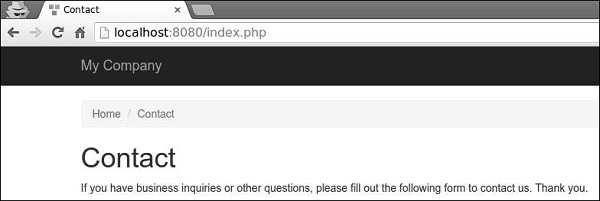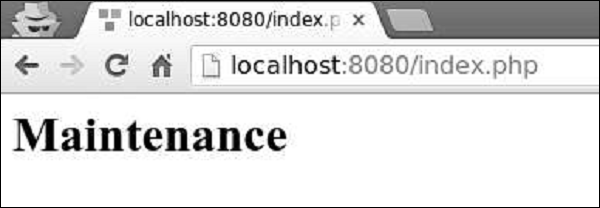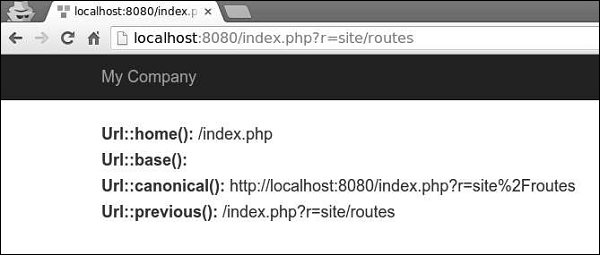
- Yii 教程
- Yii - 主页
- Yii - 概述
- Yii - 安装
- Yii - 创建页面
- Yii - 应用程序结构
- Yii - 入口脚本
- Yii - 控制器
- Yii - 使用控制器
- Yii - 使用动作
- Yii - 模型
- Yii - 小部件
- Yii - 模块
- Yii - 视图
- Yii - 布局
- Yii - 资产
- Yii - 资产转换
- Yii - 扩展
- Yii - 创建扩展
- Yii - HTTP 请求
- Yii - 响应
- Yii - URL 格式
- Yii - URL 路由
- Yii - URL 规则
- Yii - HTML 表单
- Yii - 验证
- Yii - 临时验证
- Yii - AJAX 验证
- Yii - 会话
- Yii - 使用闪存数据
- Yii - cookie
- Yii - 使用 Cookie
- Yii - 文件上传
- Yii - 格式化
- Yii - 分页
- Yii - 排序
- Yii - 属性
- Yii - 数据提供者
- Yii - 数据小部件
- Yii - 列表视图小部件
- Yii - GridView 小部件
- Yii - 活动
- Yii - 创建事件
- Yii - Behave
- Yii - 创建Behave
- Yii - 配置
- Yii - 依赖注入
- Yii - 数据库访问
- Yii - 数据访问对象
- Yii - 查询生成器
- Yii - 活动记录
- Yii - 数据库迁移
- Yii - 主题化
- Yii - RESTful API
- Yii - RESTful API 的实际应用
- Yii - 字段
- Yii - 测试
- Yii - 缓存
- Yii - 片段缓存
- Yii - 别名
- Yii - 日志记录
- Yii - 错误处理
- Yii - 身份验证
- Yii - 授权
- Yii - 本地化
- Yii-Gii
- Gii – 创建模型
- Gii – 生成控制器
- Gii – 生成模块
- Yii 有用的资源
- Yii - 快速指南
- Yii - 有用的资源
- Yii - 讨论
Yii - URL 路由
要更改应用程序的默认路由,您应该配置defaultRoute属性。
步骤 1 -按以下方式修改config/web.php文件。
<?php
$params = require(__DIR__ . '/params.php');
$config = [
'id' => 'basic',
'basePath' => dirname(__DIR__),
'bootstrap' => ['log'],
'defaultRoute' => 'site/contact',
'components' => [
//other code
?>
步骤 2 - 访问http://localhost:8080/index.php。您将看到默认的联系页面。

要将应用程序暂时置于维护模式,您应该配置yii\web\Application::$catchAll属性。
步骤 3 - 将以下函数添加到 SiteController中。
public function actionMaintenance() {
echo "<h1>Maintenance</h1>";
}
步骤 4 - 然后,按以下方式修改config/web.php文件。
<?php
$params = require(__DIR__ . '/params.php');
$config = [
'id' => 'basic',
'basePath' => dirname(__DIR__),
'bootstrap' => ['log'],
'catchAll' => ['site/maintenance'],
'components' => [
//OTHER CODE
步骤 5 - 现在输入您的应用程序的任意 URL,您将看到以下内容。

创建 URL
要创建各种类型的 URL,您可以使用yii\helpers\Url::to()辅助方法。以下示例假设使用默认 URL 格式。
步骤 1 - 将actionRoutes()方法添加到SiteController。
public function actionRoutes() {
return $this->render('routes');
}
此方法只是渲染路线视图。
步骤 2 - 在views/site目录中,使用以下代码创建一个名为routes.php的文件。
<?php
use yii\helpers\Url;
?>
<h4>
<b>Url::to(['post/index']):</b>
<?php
// creates a URL to a route: /index.php?r = post/index
echo Url::to(['post/index']);
?>
</h4>
<h4>
<b>Url::to(['post/view', 'id' => 100]):</b>
<?php
// creates a URL to a route with parameters: /index.php?r = post/view&id=100
echo Url::to(['post/view', 'id' => 100]);
?>
</h4>
<h4>
<b>Url::to(['post/view', 'id' => 100, '#' => 'content']):</b>
<?php
// creates an anchored URL: /index.php?r = post/view&id=100#content
echo Url::to(['post/view', 'id' => 100, '#' => 'content']);
?>
</h4>
<h4>
<b>Url::to(['post/index'], true):</b>
<?php
// creates an absolute URL: http://www.example.com/index.php?r=post/index
echo Url::to(['post/index'], true);
?>
</h4>
<h4>
<b>Url::to(['post/index'], 'https'):</b>
<?php
// creates an absolute URL using the https scheme: https://www.example.com/index.php?r=post/index
echo Url::to(['post/index'], 'https');
?>
</h4>
步骤 3 - 输入http://localhost:8080/index.php?r=site/routes,您将看到to()函数的一些用法。

根据以下规则,传递给yii\helpers\Url::to()方法的路由可以是相对的或绝对的 -
如果路由为空,则将使用当前请求的路由。
如果路由没有前导斜杠,则认为是相对于当前模块的路由。
如果路由不包含斜杠,则认为是当前控制器的动作ID。
yii \helpers\Url帮助器类还提供了一些有用的方法。
步骤 4 - 修改路由视图,如以下代码所示。
<?php
use yii\helpers\Url;
?>
<h4>
<b>Url::home():</b>
<?php
// home page URL: /index.php?r=site/index
echo Url::home();
?>
</h4>
<h4>
<b>Url::base():</b>
<?php
// the base URL, useful if the application is deployed in a sub-folder of the Web root
echo Url::base();
?>
</h4>
<h4>
<b>Url::canonical():</b>
<?php
// the canonical URL of the currently requested URL
// see https://en.wikipedia.org/wiki/Canonical_link_element
echo Url::canonical();
?>
</h4>
<h4>
<b>Url::previous():</b>
<?php
// remember the currently requested URL and retrieve it back in later requests
Url::remember();
echo Url::previous();
?>
</h4>
步骤 5 - 如果您在 Web 浏览器中输入地址http://localhost:8080/index.php?r=site/routes ,您将看到以下内容。
